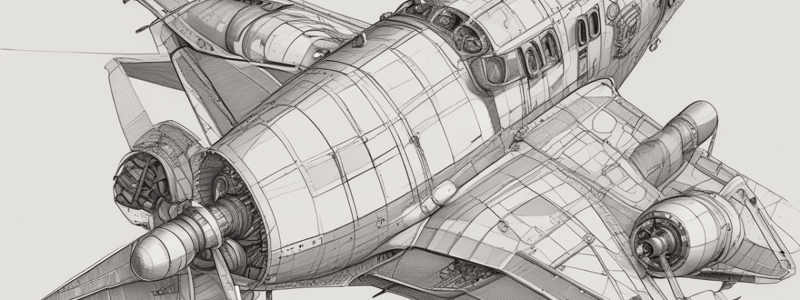Podcast
Questions and Answers
What is a rivet?
What is a rivet?
- A type of screw used for joining sheet metal
- A type of fastener that obtains its clamping action through mechanical upset (correct)
- A type of bolt used in aircraft manufacturing
- A type of adhesive used to bond aircraft parts
Which organization originates the rivet specifications AN and NAS?
Which organization originates the rivet specifications AN and NAS?
- Federal Aviation Administration (FAA)
- Military Standards (MS)
- National Aerospace Standard (NAS)
- Air Force-Navy (AN) (correct)
What do rivet specifications stipulate?
What do rivet specifications stipulate?
- The cost of the rivet
- The color of the rivet
- The dimensions and material to be used (correct)
- The country of origin of the rivet
Why do aircraft manufacturers use standard hardware like rivets?
Why do aircraft manufacturers use standard hardware like rivets?
What happens to a solid-shank rivet when it is driven into a hole?
What happens to a solid-shank rivet when it is driven into a hole?
Why are solid-shank rivets considered the most commonly used aircraft fastener?
Why are solid-shank rivets considered the most commonly used aircraft fastener?
How is the length of a universal head (AN470) rivet measured?
How is the length of a universal head (AN470) rivet measured?
In rivet codes, what does the third part represent?
In rivet codes, what does the third part represent?
What does MS20470 indicate in terms of rivet codes?
What does MS20470 indicate in terms of rivet codes?
Which system uses a one- or two-digit letter code for representing rivet alloy material?
Which system uses a one- or two-digit letter code for representing rivet alloy material?
What is the correct way to measure the length of a countersunk rivet (AN426)?
What is the correct way to measure the length of a countersunk rivet (AN426)?
What unit is used to indicate shank diameter in rivet codes?
What unit is used to indicate shank diameter in rivet codes?
What is the term for allowing an alloy to cool at room temperature?
What is the term for allowing an alloy to cool at room temperature?
How does precipitation heat-treatment differ from natural ageing?
How does precipitation heat-treatment differ from natural ageing?
Why are blind rivets sometimes preferred over solid-shank rivets?
Why are blind rivets sometimes preferred over solid-shank rivets?
What is a characteristic of Cherry friction-lock rivets?
What is a characteristic of Cherry friction-lock rivets?
What does natural ageing of an alloy involve?
What does natural ageing of an alloy involve?
In aircraft construction, why were Cherry friction-lock rivets significant?
In aircraft construction, why were Cherry friction-lock rivets significant?
What is the purpose of a mechanical-lock rivet?
What is the purpose of a mechanical-lock rivet?
Which type of rivet has a stem that breaks off after assembly?
Which type of rivet has a stem that breaks off after assembly?
What head styles are available for Cherry friction-lock rivets?
What head styles are available for Cherry friction-lock rivets?
Which type of rivet is used as a structural replacement for solid-shank rivets?
Which type of rivet is used as a structural replacement for solid-shank rivets?
What weak point is built into the stem of a friction-lock rivet?
What weak point is built into the stem of a friction-lock rivet?
How many standard diameters are Cherry friction-lock rivets usually supplied in?
How many standard diameters are Cherry friction-lock rivets usually supplied in?
What is the main difference between a Hi-Shear rivet and a standard AN bolt?
What is the main difference between a Hi-Shear rivet and a standard AN bolt?
What is the purpose of tapping a Hi-Shear rivet into its hole before swaging the locking collar?
What is the purpose of tapping a Hi-Shear rivet into its hole before swaging the locking collar?
What feature of the Hi-Shear rivet allows it to absorb high shear loads effectively?
What feature of the Hi-Shear rivet allows it to absorb high shear loads effectively?
How is a Hi-Shear rivet secured in place during installation?
How is a Hi-Shear rivet secured in place during installation?
What is the function of the two head styles available for Hi-Shear rivets?
What is the function of the two head styles available for Hi-Shear rivets?
Why is it important to ream the side wall clearance to a specific tolerance for installing a Hi-Shear rivet?
Why is it important to ream the side wall clearance to a specific tolerance for installing a Hi-Shear rivet?
Study Notes
Rivets
- A rivet is a permanent fastener that joins two or more pieces of material.
- AN and NAS rivet specifications are originated by the United States Government and are used extensively in the aerospace industry.
- Rivet specifications define the material, size, and shape of rivets, ensuring consistency and quality.
- Aircraft manufacturers use standardized hardware like rivets for several reasons:
- Interchangeability: Allows for easy replacement and maintenance.
- Quality control: Ensures consistent quality and performance.
- Cost-effectiveness: Reduced manufacturing and maintenance costs.
- When driving a solid shank rivet into a hole, its shank deforms to fill the hole, creating a tight fit.
- Solid shank rivets are considered the most commonly used aircraft fastener due to their strength, reliability, and cost-effectiveness.
- Universal head (AN470) rivets are measured from the top of the head to the end of the shank.
- The third part of a rivet code indicates the type of head and the drive method.
- MS20470 in a rivet code indicates a universal head rivet.
- The one- or two-digit letter code used for classifying rivet alloy material is part of the military standard (MS) system.
- Countersunk rivets (AN426) are measured from the bottom of the countersink to the end of the shank.
- Shank diameter is indicated in rivet codes in fractions of an inch.
- Natural ageing is a process where an alloy is allowed to cool at room temperature.
- Precipitation heat-treatment involves heating and then rapidly cooling an alloy, followed by a period of controlled aging for improved strength properties. This process is more complex and results in stronger materials compared to natural ageing.
Blind Rivets
- Blind rivets are commonly used when only one side of the joint is accessible.
- Cherry friction-lock rivets are a popular type of blind rivet known for their high strength and ease of installation.
- Natural ageing is the process of allowing an alloy to cool at room temperature for a period of time, resulting in increased strength and hardness.
- Cherry friction-lock rivets were significant in aircraft construction because they allowed for fast and efficient assembly, especially in hard-to-reach areas.
- Mechanical-lock rivets are also a type of blind rivet that rely on a mechanical locking mechanism for securing the joint.
- Stem-breaking rivets have a stem that breaks off after assembly, providing a flush finish.
- Cherry friction-lock rivets are available in various head styles, including countersunk, universal, and dome.
- Cherry friction-lock rivets are used as a structural replacement for solid-shank rivets in some aircraft applications.
- Friction-lock rivets have a weak point built into the stem, allowing for controlled breaking during installation.
- Cherry friction-lock rivets are typically supplied in five standard diameters.
Hi-Shear Rivets
- The main difference between a Hi-Shear rivet and a standard AN bolt is the locking collar used in the Hi-Shear rivet for added strength.
- Tapping a Hi-Shear rivet into its hole before swaging ensures proper alignment and a secure fit.
- The locking collar of the Hi-Shear rivet allows it to absorb high shear loads effectively.
- Hi-Shear rivets are secured in place during installation by swaging or upsetting the locking collar.
- Hi-Shear rivets are available in two head styles: countersunk and raised providing a flush or raised surface.
- Ream the side wall clearance to a specific tolerance for installing a Hi-Shear rivet to ensure proper installation and prevent damage to the surrounding materials.
Studying That Suits You
Use AI to generate personalized quizzes and flashcards to suit your learning preferences.
Related Documents
Description
Learn about the specifications and standards for aircraft hardware rivets, including identifiers like AN, NAS, and MS. Understand the purpose of rivets and how they are used in aircraft construction.




